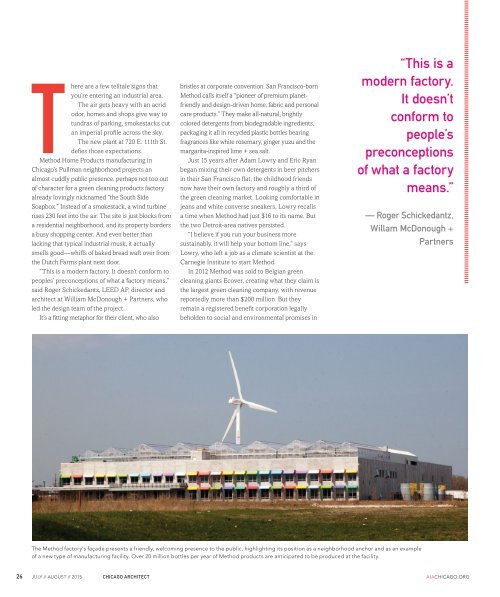okd9zlo
okd9zlo
okd9zlo
Create successful ePaper yourself
Turn your PDF publications into a flip-book with our unique Google optimized e-Paper software.
T<br />
here are a few telltale signs that<br />
you’re entering an industrial area.<br />
The air gets heavy with an acrid<br />
odor, homes and shops give way to<br />
tundras of parking, smokestacks cut<br />
an imperial profi le across the sky.<br />
The new plant at 720 E. 111th St.<br />
defi es those expectations.<br />
Method Home Products manufacturing in<br />
Chicago’s Pullman neighborhood projects an<br />
almost cuddly public presence, perhaps not too out<br />
of character for a green cleaning products factory<br />
already lovingly nicknamed “the South Side<br />
Soapbox.” Instead of a smokestack, a wind turbine<br />
rises 230 feet into the air. The site is just blocks from<br />
a residential neighborhood, and its property borders<br />
a busy shopping center. And even better than<br />
lacking that typical industrial musk, it actually<br />
smells good—whiffs of baked bread waft over from<br />
the Dutch Farms plant next door.<br />
“This is a modern factory. It doesn’t conform to<br />
peoples’ preconceptions of what a factory means,”<br />
said Roger Schickedantz, LEED AP, director and<br />
architect at William McDonough + Partners, who<br />
led the design team of the project.<br />
It’s a fitting metaphor for their client, who also<br />
bristles at corporate convention. San Francisco-born<br />
Method calls itself a “pioneer of premium planetfriendly<br />
and design-driven home, fabric and personal<br />
care products.” They make all-natural, brightly<br />
colored detergents from biodegradable ingredients,<br />
packaging it all in recycled plastic bottles bearing<br />
fragrances like white rosemary, ginger yuzu and the<br />
margarita-inspired lime + sea salt.<br />
Just 15 years after Adam Lowry and Eric Ryan<br />
began mixing their own detergents in beer pitchers<br />
in their San Francisco flat, the childhood friends<br />
now have their own factory and roughly a third of<br />
the green cleaning market. Looking comfortable in<br />
jeans and white converse sneakers, Lowry recalls<br />
a time when Method had just $16 to its name. But<br />
the two Detroit-area natives persisted.<br />
“I believe if you run your business more<br />
sustainably, it will help your bottom line,” says<br />
Lowry, who left a job as a climate scientist at the<br />
Carnegie Institute to start Method.<br />
In 2012 Method was sold to Belgian green<br />
cleaning giants Ecover, creating what they claim is<br />
the largest green cleaning company, with revenue<br />
reportedly more than $200 million. But they<br />
remain a registered benefi t corporation legally<br />
beholden to social and environmental promises in<br />
“This is a<br />
modern factory.<br />
It doesn’t<br />
conform to<br />
people’s<br />
preconceptions<br />
of what a factory<br />
means.”<br />
— Roger Schickedantz,<br />
Willam McDonough +<br />
Partners<br />
The Method factory’s façade presents a friendly, welcoming presence to the public, highlighting its position as a neighborhood anchor and as an example<br />
of a new type of manufacturing facility. Over 20 million bottles per year of Method products are anticipated to be produced at the facility.<br />
26 JULY // AUGUST // 2015 CHICAGO ARCHITECT AIACHICAGO.ORG


